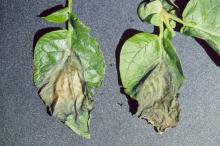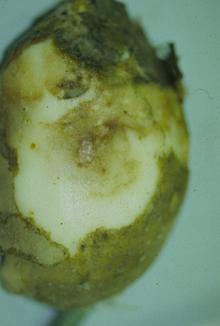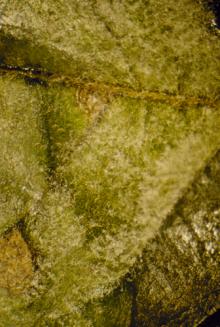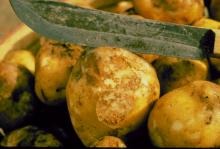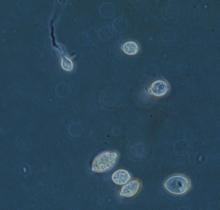By P. B. Hamm and C. M. Ocamb
Cause The fungus-like microorganism, Phytophthora infestans, survives in tubers in cull piles or on tubers left in harvested fields, on seed potatoes, or is blown in as spores with rainstorms. Spores (sporangia) form on infected culls, volunteers, or crop plants. Rain or irrigation spread sporangia to healthy tissue. Sporangia can germinate on a wet leaf or stem and penetrate either directly through the cuticle or a stomate. Under cool, wet conditions, sporangia can produce swimming spores (zoospores). The leaf or stem is colonized quickly, and large portions become necrotic as the microbe advances. At the lesion's margin, new sporangia form through the stomata to continue the disease cycle. With favorable conditions, the pathogen can complete one cycle in as little as 4 days. Many cycles can occur in the growing season. Sporangia and/or zoospores also can infect tubers throughout their development or at harvest or in storage. If potatoes with late blight are stored, the blight can directly or indirectly damage tubers. Indirect damage occurs when secondary infection, by soft rot bacteria, rots the infected tuber and then spread to other tubers below in the pile. This can be a very serious problem in storage.
In the 1990s, isolates resistant to Ridomil (metalaxyl) were found, as was a second mating type that was discovered in the Pacific Northwest. Most isolates of the pathogen are resistant to Ridomil, so its use is not recommended. The occurrence of a second mating type allows for the formation of a different survival structure, the oospore, providing an additional means for the fungus to overwinter, this time in the soil. The existence of compatible mating types also brings the risk of new strains that could be more difficult to control.
Nearly all potato varieties are susceptible to late blight. Varieties Norchip, Hilite, Russet Norkotah, Superior, Shepody, and Red LaSoda are more susceptible than Russet Burbank. The variety White Rose is similar to Russet Burbank in susceptibility. Varieties Norkotah, Russet Ranger, and Shepody are especially susceptible to late blight tuber rot. A relatively new variety, Premier Russet, is moderately resistant. Fields should be scouted early and continuously, and the use of fungicides is required. Scout areas where water pools in the field, in low spots or wheel tracks, near the center of a center pivot irrigation system, and where irrigation overlaps occur.
The disease has been found throughout the PNW. The disease is often found in the Willamette Valley of Oregon and in northwestern Washington. Since 1991, yearly outbreaks have occurred in the Columbia Basin of Oregon and Washington. The disease is less often seen in Idaho and seldom seen in central Oregon or Klamath Falls.
Symptoms Water-soaked spots appear on leaves and stems, enlarge rapidly, and turn brown or black. Under humid conditions, a ring or surface of white mold may appear on the leaf underside at the lesion's edge. In cool, wet weather, blight may advance rapidly and ruin an entire field in a few days. Lesions, with the occurrence and duration of moisture, may be found in the lower canopy while none are visible in the drier, upper canopy.
Infected tuber skin at first is discolored brown to purple; later there is a brownish dry or wet rot. Blight infections on tubers usually become visible within the first month of storage, but symptoms may continue to appear throughout the storage season.
Cultural control Regular scouting for the disease is critical for all types of management strategies.
- Eliminate cull piles from field or from storage before spring plantings. Bury under at least 2 ft of soil or feed to livestock prior to current year plantings.
- Use certified pathogen-free seed. Do not buy seed from areas known to have had late blight the year the seed was grown.
- Adequately hill plants to minimize the opportunity for sporangia to wash from the foliage into cracks or shallow areas of a hill and then to the tubers.
- Control volunteer plants where possible.
- Use irrigation management to limit disease spread. Don't water during rain storms, or soon thereafter, to reduce time water is on foliage. Watering at night prolongs moisture on leaves and should be avoided when late blight pressure is high. Use of solid set or wheel line systems for more than 4 hours is not recommended.
- To minimize tuber infection and facilitate decomposition of infected tubers, do not dig potatoes from late blight-infected fields until 14 days after frost or herbicides kill vines completely (no green stems).
- Do not harvest when soil is excessively wet.
- Provide adequate air flow in storage to prevent free water or surface moisture from forming on tubers. Late blight spores can spread in storage if temperatures are above 40°F and will infect new potatoes if there is free moisture on tubers for 12 hours or more.
- West of the Cascade Range, potatoes planted early in spring and harvested before wet weather in fall are more likely to escape severe infection.
- Do not plant the first one-half of the first tower from the center pivot to avoid providing conditions for the organism to become established in the field.
Chemical control Consult your local university Extension office for information on materials registered under Section 18. In western Oregon and Washington, apply protectant fungicides every 7 days starting at 6 inches of shoot growth. In the Columbia Basin, apply protectant fungicides beginning just before between-row closure. It is extremely important to begin fungicide applications prior to infection.
Using Ridomil products will not provide control due to resistance in pathogen strains currently found.
Seed treatments can reduce the chance of spread of late blight from seed and prevent spread of late blight between seed pieces during cutting, treating, and handling operations.
- Evolve Potato Seed Piece Treatment (Group 1 + 27 + M3) at 0.75 lb/100 lb seed pieces.
- Revus (Group 40) at 0.2 to 0.4 fl oz/100 lb of seed. 12-hr reentry.
If weather, such as heavy rain, favors late-blight infection, apply at 5- to 7-day intervals. Some formulations may be applied by solid-set and circle sprinkler systems. Treat vines with protectant fungicides, even after die-down, as long as vines are still green. Several forecasting programs are available that use local weather data to help time applications, contact your local extension office for more information.
- CAA-fungicide (Carboxylic Acid Amides) formulations (Group 40) in combination with another fungicide that has a different mode of action. Do not apply more than once before alternating to a different mode of action.
- Forum at 4 to 6 fl oz/A on 5- to 10-day intervals. Do not apply within 4 days of harvest. 12-hr reentry.
- Revus at 5.5 to 8 fl oz/A or Revus Top (Group 3 + 40) at 5.5 to 7 fl oz/A on 7- to 10-day intervals. Preharvest interval is 14 days. 12-hr reentry for Revus Top; 4-hr for Revus.
- Chlorothalonil (Group M5) products such as:
- Bonide Fung-onil is available for home gardens. H
- Bravo Ultrex at 0.7 to 1.36 lb/A or Bravo Weather Stik at 0.75 to 1.5 pints/A on 7- to 10-day intervals. Preharvest interval is 7 days. 12-hr reentry.
- Echo 720 at 0.75 to 1.5 pints/A on 5- to 10-day intervals. Preharvest interval is 7 days. 12-hr reentry.
- Echo 90 DF at 0.625 to 1.25 lb/A on 5- to 10-day intervals. Preharvest interval is 7 days. 12-hr reentry.
- Copper (Group M1) products offer limited control. Using copper products alone to control late blight is not recommended. For organic production that base late-blight fungicide program on copper formulations, according to research conducted by WSU, lower levels of copper sulfate pentahydrate can be used in combination with a chitosan sticker and complexing agent, slowing copper buildup in the soil.
- Badge SC at 1 to 4 pints/A on 5-day intervals. Preharvest interval is 0 days. 48-hr reentry.
- Bonide Liquid Copper is available for home gardens. H
- Bordeaux 8-8-100. H
- Champ Formula 2 Flowable at 0.66 to 2.66 pints/A on 5- to 10-day intervals, starting when plants are 6 inches high. Suppresses Colorado potato beetle populations. 48-hr reentry.
- C-O-C-S WDG at 1.5 to 4.9 lb/A. 48-hr reentry.
- Cueva at 0.5 to 2 gal/100 gal water on 7- to 10-day intervals. May be applied on the day of harvest. 4-hr reentry. O
- Cuprofix Ultra 40 Disperss at 0.75 to 3 lb/A on 7- to 10-intervals. 48-hr reentry.
- Kocide 2000 at 0.75 to 3 lb/A on 10- to 14-day intervals. 48-hr reentry.
- Liqui-Cop at 1.5 to 2 teaspoons/gal water. H
- Nu-Cop 50 WP at 1 to 5 lb/A on 5- to 10-day intervals. Do not apply within 14 days of harvest. 48-hr reentry. O
- Previsto at 1 to 3 quarts/A on 7- to 10-day intervals. 48-hr reentry. O
- Cymoxanil products (Group 27) such as Curzate 60DF at 3.2 oz/A or Tanos (Group 11 + 27) at 6 to 8 oz/A. Do not make more than one (1) application before alternating with a fungicide that has a different mode of action. Must be tank-mixed with an appropriate fungicide with a different mode of action (non-Group 27). Do not apply within 14 days of harvest. 12-hr reentry.
- Mancozeb products (Group M3) such as Dithane F-45 Rainshield, Polyram 80 DF, etc.; see label for rates and intervals. Do not apply within 14 days of harvest. 24-hr reentry.
- Mefenoxam and metalaxyl formulations (Group 4) are available and have good efficacy in the absence of resistant pathogen strains. Late blight strains can rapidly develop resistance to this fungicide group if not present already, so mefenoxam and metalaxyl formulations are not recommended to be used alone but rather in tank mixes in combination with other multisite fungicides effective on late blight. If resistant pathogen populations are suspected, confirm and use fungicide formulations other than Group 4.
- Ridomil Gold Bravo SC (Group 4 + M5) at 2.5 pints/A. Do not use within 14 days of harvest. 48-hr reentry.
- Ridomil Gold MZ (Group 4 + M3) at 2.5 lb/A or Ridomil Gold Copper (Group 4 + M1) at 2 lb/ A plus 0.8 lb a.i./acre of mancozeb or chlorothalonil on 14-day intervals. Do not apply within 14 days of harvest. 48-hr reentry.
- Omega 500F (Group 29) or Omega TopMP at 5.5 fl oz/A on 7- to 10-day intervals. Do not apply within 14 days of harvest. 12-hr reentry for Omega 500F; reentry for Omega TopMP is 48-hr or 96-hr reentry for high exposure activities.
- OSO 5% SC (Group 19) at 3.75 to 13 fl oz/A on 7- to 14-day intervals. Can be applied the day of harvest. 4-hr reentry. O
- Phosphorous acid-based products (Group P7; formerly Group 33) are effective.
- Alude at 2.5 to 10 pints/A on 4- to 14-day intervals. 4-hr reentry.
- Fosphite at 1 to 3 quarts in 100 gal water on 2- to 3-week intervals. 4-hr reentry.
- Previcur Flex (Group 28) at no more than 1.2 pints/A on 7- to 10-day intervals in a tank-mixture with chlorothalonil or mancozeb. Also controls early blight. Do not apply within 14 days of harvest. 12-hr reentry.
- Ranman (Group 21) at 1.4 to 2.75 fl oz/A on 7- to 10-day intervals. Do not make more than three (3) applications of Ranman (Group 21 fungicide) before alternating for three intervals to a labeled fungicide with a different mode of action. Preharvest interval is 7 days. 12-hr reentry.
- Strobilurin fungicides (Group 11) are labeled for use. Do not make more than one (1) application of a Group 11 fungicide before alternating to a labeled fungicide with a different mode of action.
- Evito 480 SC at 3.8 fl oz/A on 7-day intervals. Tank-mix or alternate with another fungicide that has a different mode of action (non-Group 11). Preharvest interval is 7 days. 12-hr reentry.
- Headline at 6 to 9 fl oz/A on 7- to 14-day intervals. Preharvest interval is 3 days. 12-hr reentry.
- Quadris Flowable at 12 to 15.5 fl oz/A on 7-day intervals. Preharvest interval is 14 days. 4-hr reentry.
- Reason 500 SC at 5.5 to 8.2 fl oz/A on 5- to 10-day intervals. Do not apply within 14 days of harvest. 12-hr reentry.
- Super Tin 80WP (Group 30) at 1.87 to 3.75 oz/A. Use only in combination with chlorothalonil, mancozeb, or Polyram 80 DF. Do not apply within 7 days of harvest. 48-hr reentry. Restricted-use pesticide.
Note: Premixes of fungicides are available and offer ease for fungicide resistance management. Do not make more than one (1) application of a Group 11 fungicide before alternating to a labeled fungicide with a different mode of action; for other fungicide groups apply no more than two (2) sequential applications alternating with another fungicide with a different mode of action.
- Dexter Max (Group M3 + 11) at 1.6 to 2.1 lb/A on 5- to 10-day intervals. Preharvest interval is 14 days. 24-hr reentry.
- Orondis Opti (Group M5 + 49) at 1.75 to 2.5 pints/A on 5- to 14-day intervals. Preharvest interval is 14 days. 12-hr reentry.
- Orondis Ultra (Group 49 + 40) at 5.5 to 8 fl oz/A on 7- to 10-day intervals. Preharvest interval is 14 days. 4-hr reentry.
- Quadris Opti (Group 11 + M5) at 1.6 pints/A on 7- to 14-day intervals. Preharvest interval is 14 days. 12-hr reentry.
- Revus Top (Group 3 + 40) at 5.5 to 7 fl oz/A on a 7- to 10-day intervals. Do not apply within 14 days of harvest. 12-hr reentry.
- Tanos (Group 11 + 27) at 6 to 8 oz/A. Must be tank-mixed with an appropriate fungicide with a different mode of action (non-Group 11 or 27). Do not apply within 14 days of harvest. 12-hr reentry.
- Zampro (Group 40 + 45) at 11 to 14 fl oz/A for no more than three (3) application per season. Preharvest interval is 4 days. 12-hr reentry.
Biological control
- Double Nickel LC at 1 to 6 quarts/A on 3- to 10-day intervals. Can be applied the day of harvest. 4-hr reentry. O
- LifeGard WG at 1 to 4.5 oz/100 gal on 7- to 14-day intervals for activating plant resistance. Apply in alternating, or tank-mix program, with compatible, labeled fungicides as part of a disease management program. Refer to label for appropriate rate per application volume. Preharvest interval is 0 days. 4-hr reentry. O
- Sonata at 2 to 4 quarts/A on 7- to 14-day intervals for disease suppression. Can be applied up to and on the day of harvest. 4-hr reentry. O
- Stargus at 2 to 4 quarts/A plus a nonionic surfactant on a 7-day interval. Preharvest interval is 0 days. 4-hr reentry. O
References Hadwiger, L.A., and McBride, P.O. 2006. Low-level copper plus chitosan applications provide protection against late blight of potato. Online. Plant Health Progress doi:10.1094/PHP-2006-0406-01-RS.
Johnson, D.A., and Hamm, P.B. 2001. Fungicide Application for Management of Potato Late Blight. WSU Coop. Ext. Pub. EB1923
Mohan, S.K., et al. Late Blight of Potato and Tomato. 1996. Univ. of Idaho Cooperative Extension System Publication CIS 1051.


